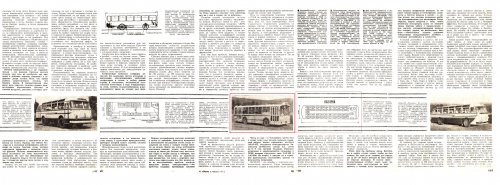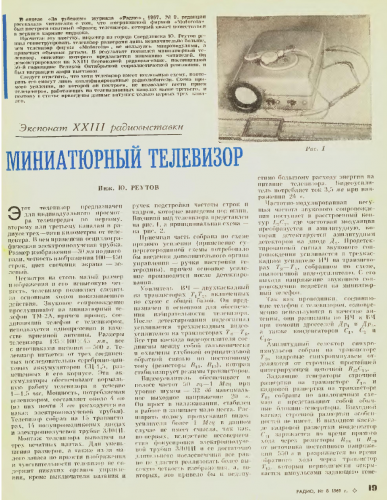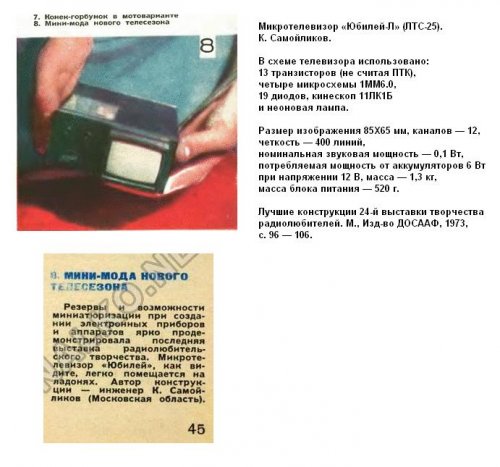Chapter to my book Unknown Soviet Union.
Micro-TV "Jubilee-L" (LTS-25). K. Samoylikov.
The TV scheme uses: 13 transistors (not counting PTC), four 1MB6.0 chips, 19 diodes, 11LK1B picture tube and a neon lamp.
The image size is 85X65 mm, the channels are 12, the clarity is 400 lines, the nominal sound power is 0.1 W, the power consumption from the batteries is 6 W at 12 V, the weight is 1.3 kg, the mass of the power unit is 520 g.
The best designs of the 24th exhibition of creativity of radio amateurs. M., Izd-vo DOSAAF, 1973, p. 96 - 106.
FIRST IN THE USSR POCKET TELEVISION Yu.Ya. Reutov In 1967, in the ninth issue of the popular technical journal "Radio", a note appeared that described the latest advertising development by Motorola - a pocket TV. Using the latest achievements of its microcircuit industry, the engineers of the company created a black and white TV, easily fit, together with power sources, in the pocket of the jacket. The antenna of the television set was the headphone wire, through which the soundtrack of the telecast was listened. As a "kinescope", a miniature, commercially available Oscillographic tube with a diameter of 33 mm and a length of 110 mm, used in radio busses, was used in the television set. The screen of this TV was the size of a postage stamp, and the color of the image was green. As a power source used sealed alkaline batteries, located in the body of the TV. Apparently, it was the first pocket TV in the world. Photos from page 60 of the magazine. Having visited, once, the store "Young Technician" at the corner of the streets of East and Pervomayskaya, I saw there on the window a domestic electron-beam tube 3LO1 of the same dimensions as in an American pocket TV. Immediately arose the thought: "What are we worse than the Americans!" Immediately, despite the fairly decent price, the tube was bought by me, and I had a purpose in life to make a TV the same size as the American, but on domestic details. I learned from acquaintances that batteries, like two drops of water similar to American ones, are used in our defense equipment and, therefore, naturally, are sold at us on a flea market. Batteries were also bought. In our scientific library, I found an American magazine, which showed a diagram of the TV company Motorola and described in detail its device. At the American TV the electronic part was collected on specially developed by the firm unique hybrid microassemblies. I decided to perform the electronics of my TV set on the usual available domestic transistors (and I had no other possibilities). I already had experience in developing and tuning lamp black-and-white TV sets and I, quite distinctly, imagined what was required of me. First of all, I achieved the appearance of a glowing rectangle of a raster on the screen of an electron-beam tube. To do this, I built a constant voltage converter of four volts from the battery, 550 volts supplied to the tube electrodes, as well as line and frame sweepers (each required only a couple of transistors, instead of seven nine for each in an American TV). The resulting green rectangle was to be modulated by a television signal. Having assembled the simplest detector receiver, I received a television signal on the oscilloscope screen, which can not be confused with anything. In one of the collections "Geophysical Apparatus" I found an amplifier circuit with only three transistors, which provided amplification of the signal from the detector cascade to a value providing observation of the television image on the screen of my tube. Strangely enough, but the most difficult was to get the sound reproduction. No matter how hard I beat, but I did not get a good sound (at acceptable device sizes). At last, the TV has earned, and there was a following problem to make for it a decent case. Here, my good friend Stas Novitsky, who worked as a laboratory assistant in our laboratory, took up his work. From beech and multilayer plywood we made a punch and die for stamping the halves of the case, heated a 500-mm sheet of yellow vinyl plastic over the electric plate and stamped the two halves of the case. The result was a pocket TV, the first in the Soviet Union.
I first read about these Soviet TVs in 2005 - 2017. They were not produced for a mass buyer. Bureaucrats.
My compatriots can tell me: do you remember TV "Rovesnik". But I've never seen it in stores. Perhaps it was sold in Moscow.
http://www.rw6ase.narod.ru/00/twcb_/rowesnik.html
Stop. TV Rovesnik sold in Moscow since 1989. But the USSR collapsed in 1991 - in fact in 1989. But I'm talking about Soviet mini-TVs in 1967 and 1970. They were not sold in stores. Fact. Why?
Микротелевизор «Юбилей-Л» (ЛТС-25). К. Самойликов.
В схеме телевизора использовано: 13 транзисторов (не считая ПТК), четыре микросхемы 1ММ6.0, 19 диодов, кинескоп 11ЛК1Б и неоновая лампа.
Размер изображения 85X65 мм, каналов — 12, четкость — 400 линий, номинальная звуковая мощность — 0,1 Вт, потребляемая мощность от аккумуляторов 6 Вт при напряжении 12 В, масса — 1,3 кг, масса блока питания — 520 г.
Лучшие конструкции 24-й выставки творчества радиолюбителей. М., Изд-во ДОСААФ, 1973, с. 96 — 106.
ПЕРВЫЙ В СССР КАРМАННЫЙ ТЕЛЕВИЗОР Ю.Я. Реутов В 1967 году в девятом номере популярного технического журнала «Радио» появилась заметка, в которой рассказывалось о новейшей рекламной разработке фирмы Motorola - карманном телевизоре. Используя новейшие достижения своей микросхемной промышленности, инженеры фирмы создали черно-белый телевизор, легко умещавшийся, вместе с источниками питания, в кармане пиджака. Антенной телевизора служил провод наушника, по которому прослушивалось звуковое сопровождение телепередачи. В качестве «кинескопа» в телевизоре использовалась миниатюрная, серийно выпускаемая американской промышленностью осциллографическая трубка диаметром 33 и длиной 110 мм, применявшаяся в радиовойсках. Экран такого телевизора был размером с почтовую марку, а цвет изображения был зеленый. В качестве источника питания использовались герметичные щелочные аккумуляторы, размещавшиеся в корпусе телевизора. Судя по всему, это был первый в мире карманный телевизор. Фото со страницы 60 журнала. Посетив, как-то раз, магазин «Юный техник» на углу улиц Восточной и Первомайской, я увидел там на витрине отечественную электронно-лучевую трубку 3ЛО1И тех же размеров, что и в американском карманном телевизоре. Сразу возникла мысль: «А чем мы хуже американцев!» Тут же, несмотря на довольно приличную цену, трубка была мною куплена, и у меня появилась цель в жизни сделать телевизор тех же размеров, что и американский, но на отечественных деталях. У знакомых я узнал, что аккумуляторы, как две капли воды похожие на американские, используются в нашей оборонной технике и поэтому, естественно, продаются у нас на толкучке. Куплены были и аккумуляторы. В нашей научной библиотеке я нашел американский журнал, в котором была приведена схема телевизора фирмы Motorola и подробно описано его устройство. У американского телевизора электронная часть была собрана на специально разработанных фирмой уникальных гибридных микросборках. Я решил выполнить электронику своего телевизора на обычных доступных отечественных транзисторах (а других-то возможностей у меня и не было). Опыт разработки и настройки ламповых черно-белых телевизоров у меня уже имелся и я, довольно отчетливо, представлял, что от меня требуется. Прежде всего, я добился появления на экране электронно-лучевой трубки светящегося прямоугольничка растра. Для этого изготовил преобразователь постоянного напряжения из четырех с небольшим вольта, получаемых от аккумулятора, в 550 вольт, подаваемых на электроды трубки, а также генераторы строчной и кадровой разверток (на каждый из них мне потребовалось всего лишь по паре транзисторов, вместо семи девяти на каждый в американском телевизоре). Полученный зеленый прямоугольничек надо было промодулировать телевизионным сигналом. Собрав простейший детекторный приемник, я получил на экране осциллографа телевизионный сигнал, который ни с чем нельзя спутать. В одном из сборников «Геофизическая аппаратура» я нашел схему усилителя всего на трех транзисторах, который обеспечил усиление сигнала с детекторного каскада до величины, обеспечивающей наблюдение телевизионного изображения на экране моей трубки. Как ни странно, но самым сложным было получение воспроизведения звукового сопровождения. Сколько я ни бился, но хорошего звука (при приемлемых размерах устройства) я так и не получил. Наконец, телевизор заработал, и встала следующая проблема изготовить для него приличный корпус. Тут за дело взялся мой хороший друг Стас Новицкий, работавший в нашей лаборатории лаборантом. Из бука и многослойной фанеры мы изготовили пуансон и матрицу для штамповки половинок корпуса, нагрели над электроплиткой полуторамиллиметровый лист желтого винипласта и отштамповали две половинки корпуса. Получился вот такой, первый в Советском Союзе, карманный телевизор.






